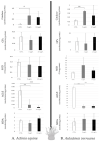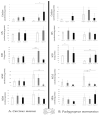The Impacts of the Multispecies Approach to Caffeine on Marine Invertebrates
- PMID: 38250985
- PMCID: PMC10823422
- DOI: 10.3390/toxics12010029
The Impacts of the Multispecies Approach to Caffeine on Marine Invertebrates
Abstract
Caffeine is one of the most consumed substances by humans through foodstuffs (coffee, tea, drugs, etc.). Its human consumption releases a high quantity of caffeine into the hydrological network. Thus, caffeine is now considered an emergent pollutant sometimes found at high concentrations in oceans and seas. Surprisingly, little research has been conducted on the molecular responses induced by caffeine in marine organisms. We studied, in laboratory conditions, six phylogenetically distant species that perform distinct ecological functions (Actinia equina and Aulactinia verrucosa (cnidarians, predator), Littorina littorea (gastropod, grazer), Magallana gigas (bivalve, filter-feeder), and Carcinus maenas and Pachygrapsus marmoratus (crabs, predator and scavenger)) subjected to caffeine exposure. The antioxidant responses (catalase, CAT; glutathione peroxidase, GPx; superoxide dismutase, SOD), lipid peroxidation (MDA), and the acetylcholinesterase (AChE) activity were estimated when the organisms were exposed to environmental caffeine concentrations (5 μg/L (low), 10 μg/L (high)) over 14 days. Differential levels of responses and caffeine effects were noted in the marine invertebrates, probably in relation to their capacity to metabolization the pollutant. Surprisingly, the filter feeder (M. gigas, oyster) did not show enzymatic responses or lipid peroxidation for the two caffeine concentrations tested. The marine gastropod (grazer) appeared to be more impacted by caffeine, with an increase in activities for all antioxidative enzymes (CAT, GPx, SOD). In parallel, the two cnidarians and two crabs were less affected by the caffeine contaminations. However, caffeine was revealed as a neurotoxic agent to all species studied, inducing high inhibition of AChE activity. This study provides new insights into the sublethal impacts of caffeine at environmentally relevant concentrations in marine invertebrates.
Keywords: caffeine; marine invertebrates; neurotoxicity; oxidative stress.
Conflict of interest statement
The authors declare no conflicts of interest.
Figures





References
LinkOut - more resources
Full Text Sources
Miscellaneous

